Introduction
This publication presents information about melaleuca weevils, Oxyops vitiosa, introduced to Florida for biological control of the invasive melaleuca tree. It contains information about melaleuca weevil natural history, biology, use as a biological control agent. The intended audience includes homeowners and land managers primarily in south Florida where Melaleuca most is prevalent.
General Background Melaleuca, Melaleuca quinquenervia (Cav.) S.T. Blake (Myrtaceae), is an invasive woody plant that is native to Australia, New Guinea, and the Solomon Islands, and is a prohibited species in Florida (Licurance 2013). Melaleuca, also known as the paper bark tree, cajeput, punk tree, or white bottlebrush tree, was introduced into Florida in the late 19th century but apparently failed to naturalize until 1906. It was planted extensively as an ornamental and eventually invaded suitable forested and non-forested wetland habitats in south Florida forming dense monocultures (Figure 1). In 2008, melaleuca occupied over 110,000 ha of wetland ecosystems in this region, most notably the sawgrass marshes that comprise the Florida Everglades. In 2003, total expenditures for melaleuca control in Florida approached $26 million (Carter-Finn et al. 2006). A combination of chemical, mechanical, cultural, and biological control practices have been used to manage melaleuca in south Florida. These methods have been successfully integrated to provide the most effective control.

Credit: Ken Gioeli, UF/IFAS
Melaleuca is not considered a weed in its native Australia because it is attacked by a complex of natural enemies. Classical biological control, which is the introduction of host-specific natural enemies, was investigated as a possible long-term solution to the melaleuca problem. Five insects have been imported into quarantine for host specificity testing by USDA scientists. The first insect released was the melaleuca snout beetle or weevil, Oxyops vitiosa (Pascoe) (Insecta: Coleoptera: Curculionidae) (Figure 2).
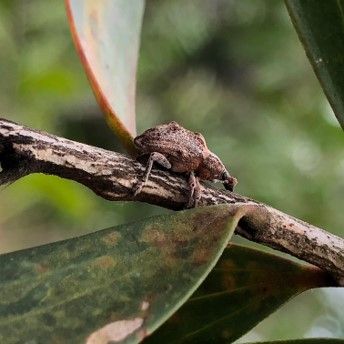
Credit: Ken Gioeli, UF/IFAS
Description
Adult
Melaleuca weevils are gray in color and 6 to 9 mm in length. Males are usually smaller than females. The adults are somewhat cryptic in appearance but are usually found on the leaves and stems of saplings (Figure 3) or the new growth of older trees, where they feed, mate, and deposit their eggs. The presence of adults is usually indicated by the characteristic feeding damage that consists of holes or gouges chewed into the buds, leaves, and stems. Occasionally, young shoot tips are nearly excised when stem feeding occurs on the tender new growth (Figure 4).
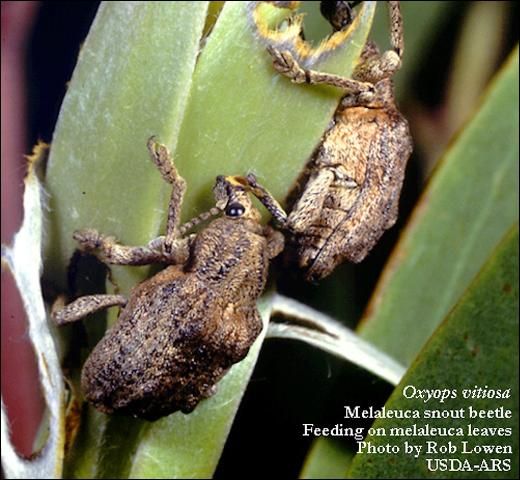
Credit: Rob Lowen, USDA-ARS
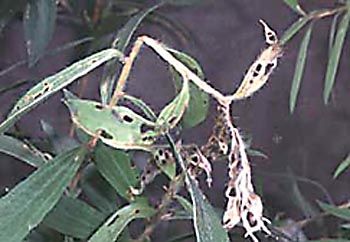
Credit: undefined
Egg
The eggs of the melaleuca weevil are yellow, 1 mm long, and resemble gel capsules (Figure 5). The female almost always covers the eggs in a secretion as soon as they are deposited to protect them from desiccation or predation. This secretion dries to form a hard protective casing, which is brown to black in color. When the eggs are present, they are usually associated with adult feeding damage.
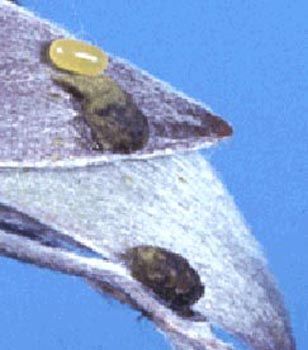
Credit: undefined
Larva
The larval stage has four instars, or growth phases. The appearance and size of the larvae vary depending upon their age. Neonates, or newly hatched larvae, are yellow and less than 1 mm long. In contrast, the mature larvae are 14 mm in length, grayish in color, and are slug-like in appearance. Developing larvae are usually covered with translucent yellow or orange oily secretion that turns black after fecal material is incorporated into it. This oily secretion mixed with fecal matter affords the larvae protection from fire ants and possibly other predators. This fecal matter is produced as a long thin coil (Figures 6 and 7).
The feeding damage produced by the larval stage is very different from the adults. Instead of chewing holes in the leaves, the larvae consume all layers of the leaf except for the cuticle on the opposite side. The appearance of the paper-thin feeding trails in the leaves produced by the developing larvae is a clear indication that melaleuca weevils are present (Figure 7). Prior to pupation, the mature larvae, or prepupae, cease feeding and are yellow in color.
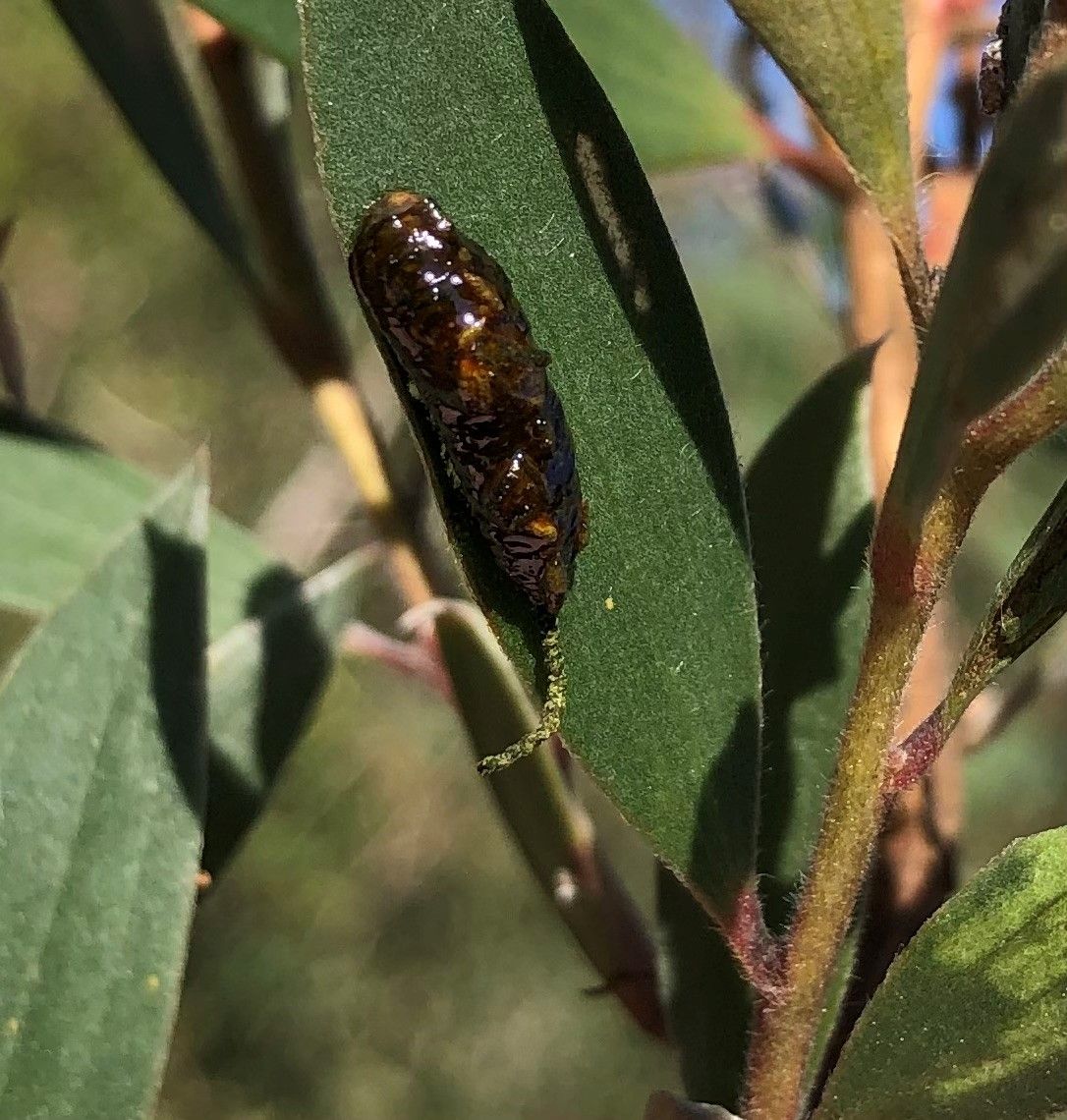
Credit: Ken Gioeli, UF/IFAS

Credit: undefined
Pupa
The pupal stage is not visible because it occurs beneath the soil surface. Larvae develop to the pupal stage inside an earthen capsule formed by the prepupae. The pupal capsule, which is made of soil and an oily secretion produced by the insect, is approximately 10 mm in diameter. The newly formed pupae are of the exarate type (i.e., the legs and wings are free and not glued to the body) and are yellowish in color but turn brown prior to emergence of the adults from the soil.
Distribution and Life Cycle
The melaleuca weevil is native to Australia. This insect was released in Florida in 1997 after Australian field studies and quarantine laboratory testing by the USDA in Florida demonstrated the weevil would reproduce only on melaleuca. Establishment of the weevil has been confirmed in all melaleuca-infested sites except those that are flooded for extended periods.
Adults feed and reproduce on the leaves and shoots of saplings as well as the new growth of mature melaleuca trees. Females begin to produce eggs when they are approximately 6 weeks old and can live up to 10 months. They will deposit up to 9 eggs per day and produce from 500 to 1000 eggs during their lives. The egg stage lasts approximately 7 days, and larvae begin to feed immediately upon hatching. Larvae will complete their development in approximately 7 weeks and migrate down the stems as they mature. When the larvae become prepupae (cease feeding), they crawl or drop to the ground to complete their development to the adult stage. The larvae will select a suitable site underground to form a pupal capsule from the surrounding soil. The insects will remain in the pupal stage for approximately 2 to 6 weeks. Based on laboratory studies, development from the egg to the adult stage occurs in approximately 12 weeks. In south Florida, new adults appeared in the field 3 months after the weevil was initially released, which suggests the melaleuca weevil is able to produce two to three generations per year in Florida's subtropical climate.
As mentioned previously, part of the life cycle of the melaleuca weevil occurs in the soil. While soil type does not appear to preclude establishment, pupation success may be higher at sites with sandy soils. Field and laboratory studies indicate the larvae can pupate under soil conditions ranging from saturated to drier areas with a high relative humidity. However, habitats in south Florida that are characterized by infrequent flooding, moderate melaleuca densities, and dry winters favor weevil establishment. Failure of the weevil to establish at permanently flooded sites suggests these conditions are not conducive to normal pupation, probably because submersed pupae cannot survive without oxygen for any length of time.
Larvae are commonly observed on melaleuca plants in south Florida from October to May, which coincides with flushes of new leaf growth. Adults are present only during the summer months unless the melaleuca is mowed or otherwise damaged. Any activity that stimulates new leaf growth (e.g., shoot regrowth from cut stumps, damaged branches, root suckering, etc.) will support larval populations year-round at a specific site.
Importance
Both adults and larvae damage melaleuca by disrupting the plants' normal growth processes. Large larvae can destroy most of the leaves on several shoots of an individual plant. At several sites in south Florida where high populations of the larvae have been observed, extensive areas of damaged melaleuca foliage are evident. Reduced flowering (up to 90%) also has been demonstrated experimentally by USDA scientists at several sites in south Florida where the weevil is established. This type of feeding damage may help to reduce seed production and prevent further spread of this highly invasive plant.
Because the insect disperses slowly, a coordinated redistribution program was used to establish the insect in all 22 counties in central and south Florida, which are infested with melaleuca. A standardized procedure for collecting and transporting the adult melaleuca weevils to other sites where the weevil is not yet established was first developed and implemented in St. Lucie County (Figure 8).
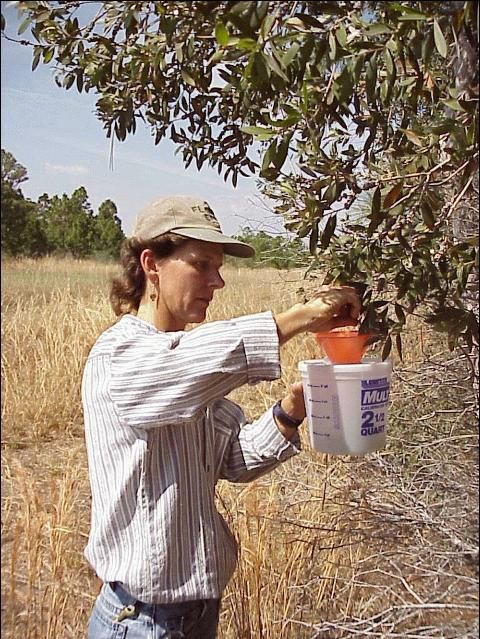
Credit: Ken Gioeli, UF/IFAS
The melaleuca weevil is one of the key components of The Areawide Management and Evaluation of Melaleuca, or T.A.M.E. Melaleuca (TAME Melaleuca 2007). This pest management program, which was initiated in 2001, was designed to promote long-term, biologically-based melaleuca management through partnerships with public agencies and private land managers. The goal of T.A.M.E. melaleuca was to demonstrate the effectiveness of an IPM program for controlling melaleuca in the United States and beyond. Ecosystem recovery has been documented during a 17-year period (1997–2014) following the release of biological control agents of the melaleuca tree. Formerly dense melaleuca stands are gradually changing to more diverse plant communities consisting of mostly native species following an 85% reduction in melaleuca trees. Other melaleuca biological control agents include the melaleuca psyllid (Boreioglycapsis melaleucae) which was released in Florida in February 2002 (Wineriter et al. 2003), and the melaleuca gall midge (Lophodiplosis trifida) in 2008 (Moore et al. 2016).
Selected References
Balciunas, J.K., D.W. Burrows, and M.F. Purcell. 1994. "Field and laboratory host ranges of the Australian weevil, Oxyops vitiosa (Coleoptera: Curculionidae), a potential biological control agent for the paperbark tree, Melaleuca quinquenervia." Biol. Contrl. 4: 351–360.
Carter-Finn, K., A.W. Hodges, D. J. Lee, and M.T. Olexa. 2006 (revised 2013). Benefit-Cost Analysis of Melaleuca Management in South Florida. FE673. Gainesville: University of Florida Institute of Food and Agricultural Sciences https://edis.ifas.ufl.edu/fe673
Center, T.D. et al. 2000. "Field colonization of the melaleuca snout beetle (Oxyops vitiosa) in south Florida." Biol. Contrl. 19: 112–123.
Center, T.D., F.A. Dray, and V.V. Vandiver, Jr. 2000. Biological Control with Insects: The Melaleuca Snout Beetle. SS-AGR-144. Gainesville: University of Florida Institute of Food and Agricultural Sciences. https://edis.ifas.ufl.edu/ag022
Ferriter, A., B. Doren, R. Winston, D. Thayer, B. Miller, B. Thomas, M. Barrett, T. Pernas, S. Hardin, J. Lane, M. Kobza, D. Schmitz, M. Bodle, L. Toth, L. Rodgers, P. Pratt, S. Snow and C. Goodyear. 2007. Chapter 9: The Status of Nonindigenous Species in the South Florida Environment. In: 2007 South Florida Environmental Report - Volume I.
Langeland, K.A., H.M. Cherry, C.M. McCormick, and K.A. Craddock Burks. 2008. Identification and Biology of Nonnative Plants in Florida's Natural Areas, 2nd edition. UF/IFAS Publication SP 257. Gainesville: University of Florida Institute of Food and Agricultural Sciences.
Lieurance, D. S., L. Flory, A. L. Cooper, D. R. Gordon, A. M. Fox, J. Dusky, and L. Tyson. 2013. Assessment of Normative Plants in Florida's Natural Areas: Gainesville: University of Florida Institute of Food and Agricultural Sciences. Assessment of Nonnative Plants in Florida's Natural Areas: History, Purpose, and Use. (November 2013). https://edis.ifas.ufl.edu/publication/AG376
Montgomery, B.R. and G.S. Wheeler. 2000. "Antipredatory activity of the weevil Oxyops vitiosa: a biological control agent of Melaleuca quinquenervia." J. Insect Behavior 13: 915–926.
Moore, M.R., Cuda, J.P., Pratt, P.D., and Rayamajhi, M.C. 2016. (Revised 2019). Melaleuca Gall Midge (suggested common name) Lophodiplosis trifida Gagné (Insecta: Diptera: Cecidomyiidae: Cecidomyiinae: Cecidomyiini). EENY655. Gainesville: University of Florida Institute of Food and Agricultural Sciences. https://edis.ifas.ufl.edu/publication/IN1140
Purcell, M.F. and J.K. Balciunas. 1994. "Life history and distribution of the Australian weevil, Oxyops vitiosa (Coleoptera: Curculionidae), a potential biological control agent for Melaleuca quinquenervia (Myrtaceae)." Ann. Entomol. Soc. Am. 87: 867–873.
Rodgers, L., M. Bodle, D. Black, F. Laroche, P. Pratt, A. Boughton, M. Renda, and K. Serbesoff-King. 2012. Chapter 7: Status of Nonindigenous Species. In: 2012 South Florida Environmental Report - Volume I - The South Florida Environment.
TAME Melaleuca, Solutions for Your Life, UF/IFAS Extension. https://tame.ifas.ufl.edu/index.shtml
Wheeler. G.S. 2000. Sequestration of Melaleuca quinquenervia defensive chemistry by Oxyops vitiosa and its relevance to biological control of weeds, p. 431. In Spencer, N.R. (ed.), Proc. X Intl Symp. Biol. Contrl. Weeds, 4–14 July 1999. Montana State University, Bozeman, MT.
Wineriter, S. and G.R. Buckingham. 1997. "Love at first bite-introducing the Australian melaleuca weevil." Aquatics 19: 10–12.
Wineriter, S.A., Halbert, S.E., and J.P. Cuda. 2003 (revised 2017). A Psyllid, Boreioglycaspis melaleucae Moore (Insecta: Hemiptera: Psyllidae). EENY300. Gainesville: University of Florida Institute of Food and Agricultural Sciences https://edis.ifas.ufl.edu/pdf/IN/IN49500.pdf